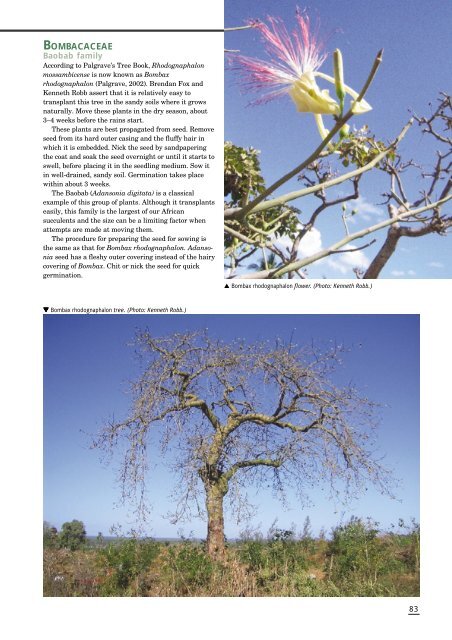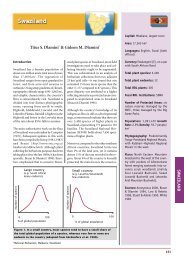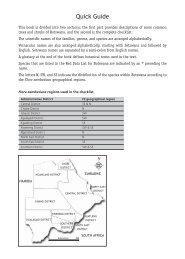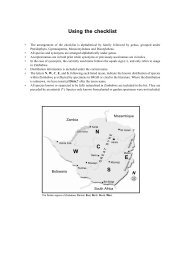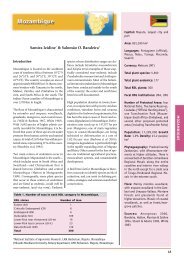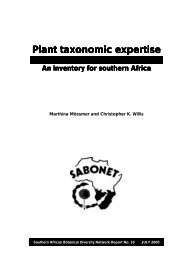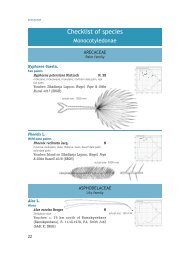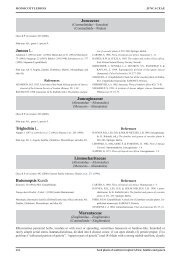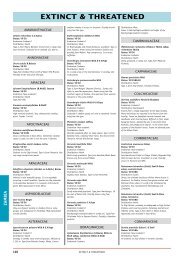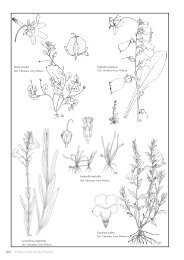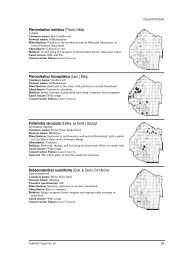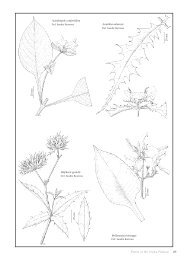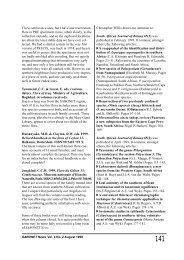Bombacaceae-Connaraceae - SABONET
Bombacaceae-Connaraceae - SABONET
Bombacaceae-Connaraceae - SABONET
You also want an ePaper? Increase the reach of your titles
YUMPU automatically turns print PDFs into web optimized ePapers that Google loves.
BOMBACACEAE<br />
Baobab family<br />
According to Palgrave’s Tree Book, Rhodognaphalon<br />
mossambicense is now known as Bombax<br />
rhodognaphalon (Palgrave, 2002). Brendan Fox and<br />
Kenneth Robb assert that it is relatively easy to<br />
transplant this tree in the sandy soils where it grows<br />
naturally. Move these plants in the dry season, about<br />
3–4 weeks before the rains start.<br />
These plants are best propagated from seed. Remove<br />
seed from its hard outer casing and the fluffy hair in<br />
which it is embedded. Nick the seed by sandpapering<br />
the coat and soak the seed overnight or until it starts to<br />
swell, before placing it in the seedling medium. Sow it<br />
in well-drained, sandy soil. Germination takes place<br />
within about 3 weeks.<br />
The Baobab (Adansonia digitata) is a classical<br />
example of this group of plants. Although it transplants<br />
easily, this family is the largest of our African<br />
succulents and the size can be a limiting factor when<br />
attempts are made at moving them.<br />
The procedure for preparing the seed for sowing is<br />
the same as that for Bombax rhodognaphalon. Adansonia<br />
seed has a fleshy outer covering instead of the hairy<br />
covering of Bombax. Chit or nick the seed for quick<br />
germination.<br />
Bombax rhodognaphalon tree. (Photo: Kenneth Robb.)<br />
Bombax rhodognaphalon flower. (Photo: Kenneth Robb.)<br />
83
BORAGINACEAE<br />
Forget-me-not family<br />
Cynoglossum alticola is relatively easy to grow<br />
from seed, provided the seed is collected before<br />
animals moving past the plants have a chance to<br />
disperse it. The seeds are presented high at the<br />
end of the old inflorescence in grassland. The fruits<br />
are four nut-like structures joined together. The testa<br />
bears hook-like bristles or hairs, which enable the seed<br />
to attach itself to any furry animal that brushes against it.<br />
In the dormant season, the partially woody underground<br />
stem can be cut into pieces of about 150 mm. These pieces<br />
will re-sprout and root in the new season.<br />
84<br />
Bombax rhodognaphalon fruit. (Photo: Kenneth Robb.)<br />
Bombax gnaphalocarpon flower.<br />
Cordia caffra seedling showing the pleated cotyledon of this genus.
Ehretia rigida is best propagated from seed, and<br />
although I have not tried cuttings, I suspect that semihardwood<br />
cuttings will work if taken in spring. Layering<br />
may work well to propagate Ehretia rigida, as it suckers<br />
from damaged roots. Cordia is best grown from seed,<br />
which germinates readily, provided the outer flesh has<br />
been cleaned off before it is sown. Germination takes place<br />
in about 14 days or less if the weather is warm and the<br />
soil is damp. The cotyledons of Cordia caffra have an<br />
interesting pleated shape.<br />
I am not familiar with Cystostemon, but I would<br />
suggest that the plants are visited regularly to monitor<br />
seed maturity. Collect the seed, remove the testa and<br />
sow—follow the same procedure as for the other<br />
boraginaceous species.<br />
BURSERACEAE<br />
Myrrh family<br />
This is a group of plants that is well suited to the harsh<br />
African continent. Collect seed and remove the red aril.<br />
Seed germinates within about 14 days. Many species will<br />
also grow from cuttings, but as I am not familiar with the<br />
Namibian contingent, this calls for experimentation.<br />
Species from the extreme desert areas should be treated<br />
like succulents. Water only when the soil has dried out<br />
and only in the so-called “rainy season”. Keep the plants<br />
hot and well-drained, especially if grown in containers.<br />
Commiphora neglecta is grown from seed in late<br />
summer. Root cuttings also work well. Break off bits of the<br />
succulent roots and lay them in river sand—shoots will<br />
appear in a couple of months. Propagation from normal<br />
cuttings or truncheons does not work at all.<br />
BUXACEAE<br />
Box family<br />
I believe that this group of plants is probably the<br />
slowest-growing of southern African woody plants.<br />
Like Buxus nyasica in Malawi, the two species in<br />
South Africa that are known to me have a very<br />
disjunct distribution. Specimens might be found in a<br />
section of a forest, but not throughout the forest.<br />
Propagation works best from seed, but the plants grow<br />
slowly, if steadily. Seed is shiny black and hard-coated.<br />
I find that seed of Buxus natalensis germinates better<br />
if the hard coat is lightly scarified with sandpaper.<br />
Sow the seed in the spring, just as the new growing<br />
season starts. Germination takes about 2–3 weeks.<br />
Seedlings develop very slowly and a five-year-old plant<br />
is not much taller than about 20 cm.<br />
The seed of Buxus macowanii germinates in about 3<br />
weeks. There are often many seedlings growing under<br />
the parent trees. Collect these as “wildings”. The<br />
leaves of the seedlings up until about 5 years old are<br />
thin and fine in texture and do not resemble the leaves<br />
of a mature plant at all. This is also the case with the<br />
Sneezewood tree, Ptaeroxylon obliquum.<br />
CAMPANULACEAE<br />
Bellflower family<br />
I have grown Wahlenbergia from seed in a humus-rich,<br />
sandy soil with no fertiliser. I collected the capsules just<br />
before they split and sowed the seed a day or so after it<br />
was shed in the early summer. The trays were filled with<br />
seedling mix and seed was treated like any other fine<br />
seed. It germinated after about 2 weeks. Young seedlings<br />
were planted out directly into the open ground. They are<br />
still growing happily a couple of years later.<br />
Cuttings should be taken from tips in early spring and<br />
set in sharp river sand with a mistbed and bottom heat.<br />
On the KwaZulu-Natal coast, I have been able to split<br />
or divide a clump and increase the number of plants. This<br />
method of propagation, however, does not contribute to a<br />
greater genetic diversity.<br />
The alpine species of this family form very tight clumps<br />
and I suspect that cuttings will strike. Make sure that<br />
there is a growing season ahead before attempting<br />
propagation by division.<br />
I believe that seed propagation is a better option, but<br />
this requires patience and good timing in collecting seed.<br />
CANELLACEAE<br />
White cinnamon family<br />
Warburgia takes root after about 90 days in a mistbed.<br />
The alternative is to sever roots of a finger-thickness of a<br />
wild tree with a spade and wait for the tree to produce its<br />
own new shoots from the cut root. Once the shoot is well<br />
established, cut it away from the parent plant. This<br />
method is known as ground or root layering.<br />
The following observation pointed me in the direction of<br />
Buxus natalensis fruit with shiny black seed visible inside.<br />
BURSERACEAE<br />
85
86<br />
WARBURGIA SALUTARIS<br />
by Richard Symmonds & Neil Crouch<br />
MEDICINAL VALUE AND CONSERVATION STATUS<br />
The stem and, to a lesser degree, the root-bark of<br />
Warburgia salutaris (Pepper-bark tree) or isibaha as it is<br />
known to the Zulu, is one of the most sought-after medicinal<br />
plant commodities in the southern African traditional<br />
health care sector (Gerstner 1938; Cunningham 1990;<br />
Williams 1996; Mander 1997; 1998; Marshall 1998). Its<br />
near-panaceal qualities were early recognised, not only by<br />
the traditional users but also by the taxonomist who<br />
awarded it the epithet “salutaris,” meaning healthful or<br />
wholesome (Zimmer 1949). Rather than here listing the<br />
various uses (which range from the relief of mouth sores to<br />
the treatment of malaria), readers are referred to the<br />
accounts of Bryant (1909), Gerstner (1938), Gordon<br />
(1953), Van Warmnelo (1953), Smith (1966), Gelfand et al.<br />
(1985), Mabogo (1990), and Hutchings & van Staden<br />
(1994) for such details.<br />
The widespread popularity of Warburgia has led to its<br />
extensive over-collection and decline in the wild (Gerstner,<br />
1946; Gordon, 1953; Cunningham, 1988; Nichols, 1990;<br />
Hollmann, 1994; Mahende, 1994; Hollmann, 1996; Mander,<br />
1998; Marshall, 1998; Scott-Shaw et al., 1998) even within<br />
protected areas (Johnson et al., 1995). This threat to its<br />
survival has long been recognised, In 1938, Gerstner wrote<br />
“...there are all over the country only poor coppices,<br />
every year cut right down to the bottom, used all over<br />
and sold by the Native herbalists as one of the most<br />
famous expectorants.”<br />
A recent global conservation status assessment<br />
(Oldfield et al., 1998) has accordingly listed W. salutaris<br />
as a taxon in danger of extinction (EN Alacd), necessitating<br />
a species-recovery approach to its conservation.<br />
In light of this, these propagation notes are an attempt<br />
to document, in particular, the shoot-tip cutting technique<br />
developed at Durban’s Silverglen Medicinal Plant Nursery<br />
during the mid-1980s. Following on this success, HL&H<br />
Mining Timber collected 500 shoot-tip cuttings from<br />
Silverglen and subsequently rooted them at their Tree<br />
Improvement Centre at White River (Johnson et al., 1995).<br />
From this stock, and materials obtained through nature<br />
conservation bodies, 100,000 plants were timeously<br />
propagated to promote W. salutaris as Tree of the Year in<br />
1996 (De Cock, 1995; Esterhuyse, 1996). Several enterprises<br />
and many individuals, including traditional healers<br />
(Crouch & Hutchings, 1999), have subsequently benefited<br />
from access to these young trees.<br />
Pepper-bark trees have great potential as ornamental<br />
subjects. With their glossy foliage, fine oval shape, and<br />
fairly rapid growth rate (especially when established in<br />
well-composted planting holes), plants make suitable<br />
screening subjects. They may also be pruned and shaped<br />
into a hedge.<br />
Trees (in Durban) planted substantially south of their<br />
normal distribution range have evidently acclimatised to a<br />
special feature<br />
variety of local conditions. This may reflect their tolerance<br />
toward a broad range of habitats (Marshall 1998). However,<br />
one can’t help but wonder whether isibaha did at one time<br />
grow around Durban, but has been driven to local extinction<br />
through over-exploitation. Such has been the fate of<br />
Wild Ginger and bushman’s tea. From both a social and<br />
economic perspective, more of this highly sought-after<br />
medicinal tree should be planted in park landscape and<br />
agricultural contexts.<br />
PROPAGATION<br />
Propagating from seed<br />
Growing W. salutaris from seed is possibly the simplest<br />
and most rewarding way of bulking up this species.<br />
However, the voracious attentions of fruit flies and monkeys<br />
make the harvesting of viable seed virtually impossible.<br />
Fruits ripen between October and December, allowing for<br />
cleaning and sowing over this period. Before sowing, the<br />
hard brown-black seeds should be removed from the fruit<br />
pulp—this process is greatly facilitated by soaking the<br />
fruits in a bucket of cold water overnight. Seeds should be<br />
sown in trays on a mixture of sieved compost and river<br />
sand (1:1) and lightly covered with the same. No pretreatment<br />
is required, for seeds germinate readily, and start<br />
emerging after about 21 days.<br />
Freshly collected and sown seed should give a return of<br />
80% within 2 months of sowing. Storage of seed is not<br />
advised for they are probably recalcitrant (seeds that lose<br />
viability after drying out). Seedlings should be left in the<br />
trays until they reach 5 cm in height, or the two-leaf stage,<br />
when they may be re-potted into 1.5 litre bags in river sand<br />
and compost (1:2). Seedlings established from seed sown<br />
in December 1996 are now in 6 litre bags and stand 1.5<br />
metres tall.<br />
Shoot-tip cuttings<br />
Propagation using shoot-tip cuttings is currently the best<br />
way of bulking up Pepper-bark plant numbers, given the<br />
shortage of viable seed. Long tip cuttings are taken, which<br />
consist of the top 15 cm length of new apical shoots.<br />
Depending on the time of the year that the shoot-tip<br />
cuttings are taken, the tip types will vary from semihardwood<br />
to softwood. Experience has shown that the<br />
harder tip cuttings perform better in the Silverglen environment.
top left Ripe fruit (40–50 mm in diameter) of Warburgia salutaris stung by fruit flies; top right Warburgia salutaris; bottom left The beautiful<br />
trunks of Warburgia salutaris growing in a grove in northern KwaZulu-Natal; bottom right Warburgia salutaris makes a fine hedge.<br />
Cuttings are best collected early in the morning and kept<br />
in a bucket of water during the selection and cutting<br />
process. Cuttings embodying 3–4 nodes (8–10 cm,<br />
trimmed from the original 15 cm-long tip) are stripped of<br />
their lower leaves. A clean cut is made at the base of a node<br />
and the top 3–4 leaves are trimmed to reduce the<br />
transpirative surface. This cropping reduces the likelihood<br />
of the cuttings drying out and perishing. The material is<br />
inserted in washed river sand under mist, and the misting<br />
timer set to 5-second sprays at 10-minute intervals. The<br />
mistbeds are bottom-heated at 24 ° C by electrical heating<br />
cables. Bottom heating improves the strike rate for it<br />
promotes callusing at the basal node, a necessary step in<br />
the development of roots.<br />
Rooting<br />
Typically, cuttings take between three and four months to<br />
establish before they are ready to be re-potted into 1.5 litre<br />
bags of river sand and compost (1:2). Root initiation can be<br />
evidenced as quickly as 45 days. The rooting period can be<br />
reduced if rooting hormones are applied, or stricter<br />
environmental control (for example temperature, mist-drift)<br />
is exercised at the mistbed site. However, Silverglen<br />
typically undertakes simple, cost-effective propagation<br />
protocols —although adequate, these procedures are not<br />
always the quickest!<br />
With Durban’s relatively moderate climate, cuttings can<br />
be taken throughout the year. The average annual strike rate<br />
of healthy cuttings has been 52%. The lowest recorded<br />
return is 34% for cuttings taken in June, and the highest<br />
73% for those cut in March. The growth rate of plants so<br />
propagated is moderate; cuttings taken from a population in<br />
Mpumalanga in December 1997 have already been repotted<br />
in 6 L bags, and presently stand about 50 cm tall.<br />
These plants are ready to be planted out in Silverglen’s<br />
Warburgia field genebank, which doubles as the mother<br />
stock from which the cuttings are taken.<br />
Many variables are involved in the rooting process, such<br />
as air temperature, humidity, photoperiod, age and state<br />
and source of the mother stock and these have clearly not<br />
been adequately controlled in our “experiment”. However,<br />
despite this, we feel that the pronounced rooting response<br />
evident during the months of March and August may be<br />
linked to the photoperiod, or day-length. These two months<br />
correspond to the spring (vernal) and autumn equinoxes,<br />
times of the year when there is as much daylight as<br />
darkness during a 24-hour period. One may reasonably<br />
ask—why are the cuttings not “day-neutral”? Are they<br />
controlling their own response to day length, or are they<br />
expressing hormones carried over from the mother stock?<br />
The effects of photoperiod are well researched and<br />
evidenced in other hormonally driven life processes, the<br />
most obvious of which is flowering. Although most<br />
angiosperms exhibit a single flowering period, some offer<br />
biannual displays. Plectranthus zuluensis is a good<br />
example, for it flowers well in March (autumn), as indeed<br />
most members of the genus do, but then produces a<br />
second display in September over the vernal equinox. The<br />
prevalent photoperiod, or ratio of light to dark (1:1) likely<br />
triggers this process.<br />
87
making the first root cuttings from this species—these<br />
became the plants at Silverglen. Along the shores of Lake<br />
St Lucia, the hippo must leave the safety of the water at<br />
night to move on to the land to graze. Hippos are not<br />
exactly light beasts and wherever their feet touch the<br />
damp soil at the lake edge they leave an impression at<br />
least 100 mm deep. This action of foot-on-soil damages the<br />
roots of Warburgia salutaris—the animal equivalent of<br />
the guillotine. Damaged root tips send out shoots and it is<br />
these “root suckers” that we have up until now used as<br />
propagules.<br />
The roots plus the shoots are gently taken out of the<br />
soil and placed in a mist propagation bed in the nursery.<br />
After about two months in a mistbed, warmed with undersoil<br />
heating cables and supplied with a fine intermittent<br />
mist of water over the foliage, the cuttings are ready to be<br />
weaned to normal growing conditions. Then after a<br />
further two months, the<br />
plants are ready to be<br />
planted in the open.<br />
CAPPARACEAE<br />
Caper family<br />
In my experience,<br />
genera such as<br />
Capparis, Cadaba,<br />
Bachmannia,<br />
Cladostemon, and<br />
Maerua all grow well<br />
from root suckers, albeit<br />
slowly. The most<br />
efficient way to propagate<br />
any of these<br />
species is from seed.<br />
However, birds and<br />
animals often eat the<br />
fruit while it is still relatively green. In KwaZulu-Natal,<br />
fruits will be ripe even though they haven’t yet changed<br />
colour. Birds are especially good at detecting this.<br />
The woody capsule of Capparis tomentosa must be ripe<br />
before the fruit is picked. The seed is contained in a rather<br />
palatable, mucilaginous, sticky flesh, and needs to be<br />
removed before the seed is sown. Either abrade the seed<br />
with a mixture of sand and water, or take the seed and<br />
place it in about 500 ml of water mixed with a couple of<br />
tablespoons of sugar. Allow the mixture to ferment for a<br />
few days. When fermented, the flesh will wash off easily.<br />
Use one of these methods to clean the seed of Boscia<br />
albitrunca and B. foetida. Sow the seed as soon as possible<br />
to maintain its viability—it takes about 3 weeks to<br />
germinate. Transfer the seedlings to their own packets or<br />
containers and fertilise with nitrogen. If they do not get<br />
enough nitrogen, the seedlings soon take on a yellow, pale<br />
look and stop growing. Even with fertiliser, the seedlings<br />
seem to stagnate after acquiring about four leaves. In fact,<br />
the plant is putting all its energy into making a huge<br />
tuber under the ground. It is important to remember that<br />
feeding is essential. The plants also like to be fairly rootbound.<br />
Cleome is best grown from seed. Watch the plants<br />
closely and collect the capsules just before they split.<br />
88<br />
Cadaba natalensis fruit with<br />
seeds surrounded by orange flesh.<br />
Cleome seed germinates if sown immediately in disturbed<br />
soil with not too much fertiliser. Sow seed approximately<br />
two weeks before the new growing season is about to<br />
begin.<br />
CARYOPHYLLACEAE<br />
Carnation family<br />
The Carnation family is relatively easily grown in normal<br />
potting soil with adequate nutrient levels. Seed is the best<br />
method of propagation—plants produce masses of seed<br />
that germinates well in seedling trays. They germinate<br />
within about 3 weeks. I have been able to grow Dianthus<br />
zeyheri from seed without a problem. The seed capsules<br />
should be watched carefully and collected as they start to<br />
split and shed their seed. Dry the capsules in a tray lined<br />
with newspaper in a dry, shady area. Sow the seeds<br />
immediately as they are shed. In KwaZulu-Natal, Dianthus<br />
flowers in early summer and the seed is ready to sow<br />
in about 6 weeks. This gives ample time for the young<br />
seedlings to germinate and become established before<br />
winter. Leave the seedlings in their trays for the first<br />
season and prick them out in the following summer.<br />
Other propagation methods for Dianthus and Silene<br />
include tip cuttings and division.<br />
The species of Dianthus that are endangered should be<br />
propagated as early in the season as possible to allow<br />
enough time for the seedlings to become established<br />
before winter or the dry season.<br />
CELASTRACEAE<br />
Staff-tree family<br />
This family is relatively easily grown from seed. It is<br />
widely distributed in southern Africa.<br />
In my experience, one should wait until about a third of<br />
the visible fruit is beginning to split open. Pick a branch<br />
that is full of fruit and hang it over a tray or box to catch<br />
the fruit when they drop. The seed is usually covered by a<br />
fleshy white, yellow, or orange aril. Remove it and sow<br />
immediately. (I suspect that this family has recalcitrant<br />
seed.) The seed germinates within 2–4 weeks after<br />
sowing. Use a well-drained, inert seedling mix. Start<br />
adding nutrients only once the little seedlings have been<br />
pricked out into trays or bags. I prefer small containers—<br />
they provide better support for the roots, which are weak<br />
initially. Although not rapid growers, the plants do well<br />
once placed in open ground. These trees and shrubs<br />
generally tend to produce large amounts of seed, so I<br />
haven’t yet attempted to grow them from cuttings.<br />
CHENOPODIACEAE<br />
Goosefoot family<br />
This family is one of extremes. We have many introduced<br />
weedy species, as well as our own, native species. They<br />
live at the remotest edges of plant growth, either in semidesert<br />
or as dwellers of the most severe salt marsh and<br />
semi-marine conditions. I have no experience in growing<br />
any of these plants and would like to know of others who<br />
might have grown them. My only advice is to try cuttings<br />
of the desert species as these may well root. I would<br />
suggest the focus is on protecting the habitat of the salt<br />
marsh species, rather than ex situ propagation attempts.
See if you can collect seed to sow in suitable habitats,<br />
undisturbed by humans.<br />
COMBRETACEAE<br />
Combretum family<br />
My experience with this family is that it is best grown<br />
from seed. The seed tends to be fairly highly parasitised.<br />
Collect as much fruit as you can from as many trees as<br />
you can. This takes time and energy, but is worth the<br />
trouble, ensuring that at least some would be free of<br />
parasites. Gather the fruit in a sack and crush all the<br />
wings. This crushing makes the seed less bulky and easier<br />
to sow in large seedling beds. Seed germinates within<br />
about 14 days, but depending on ambient temperature,<br />
this may be as short at 7 days or as long as a month or<br />
more in colder areas.<br />
Pteliopsis is sown in the same way and prefers sandy,<br />
nutrient-poor soils with plenty of organic matter. Growth<br />
is slow in containers, but rapid in the ground. Do not be<br />
concerned if the plants grow sideways! The branches will<br />
pick up once the lignin is set down in the winter resting<br />
months. These plants have a weeping habit and do not<br />
need to be pruned too early in their lives.<br />
In the case of Combretum and Terminalia, carefully<br />
remove the actual seed kernel from the outer casing and<br />
sow this. In this way, the seed sown is of good quality and<br />
seed germination happens quicker. By leaving the outer<br />
casing around the kernel, a high degree of seed predation<br />
is possible. The Kew Millennium Seed Bank staff X-ray<br />
their seed to check for fertile and infertile seeds. It is<br />
astounding how the huge cotyledons of the genus<br />
Combretum can be compressed into one seed.<br />
The rule of thumb I have employed<br />
regarding these two genera is that<br />
if I want 100 plants, I sow<br />
1,000 seeds. The proportion of germination success is 1:10.<br />
Always collect more seed than needed, because it is better<br />
to grow more plants than have too few. Furthermore,<br />
when huge amounts of energy and time are spent mounting<br />
a collecting expedition, it is unlikely that one will<br />
return to the location to collect more seed in the near<br />
future.<br />
Combretum seeds.<br />
COMBRETACEAE<br />
ARECACEAE<br />
Gymnosporia grandifolia fruit dehiscing. The aril surrounding the<br />
seed is visible.<br />
89
CONNARACEAE<br />
Itch-pod family<br />
In some books, Rourea minor is the synonym of<br />
Santaloides afzelii (Beentje, 1994). Cnestis polyphylla and<br />
Rourea species are scandent shrubs, rather than trees.<br />
The tree-forming species perform best from seed, but seed<br />
may not be produced each season. Cnestis, for example,<br />
needs full sun to flower. The fruits of this family resemble<br />
legume pods. The seed is usually black with a yellow<br />
fleshy aril, indicating that it is recalcitrant and therefore<br />
important to sow immediately. Remove the outer skin<br />
from the seed before it is sown.<br />
I have no experience regarding propagation from<br />
cuttings.<br />
Cnestis polyphylla fruit.<br />
90<br />
INTERESTING FACT<br />
I have observed Cnestis plants growing vigorously in a forest, but<br />
the leaves were in the understorey and it never flowered. The next<br />
season, when I visited the same Cnestis plant, there were masses<br />
of flowers and fruit. Sunlight, caused by an opening in the canopy<br />
created by a collapsed tree, was responsible for the sudden burst of<br />
flowers and fruit.


